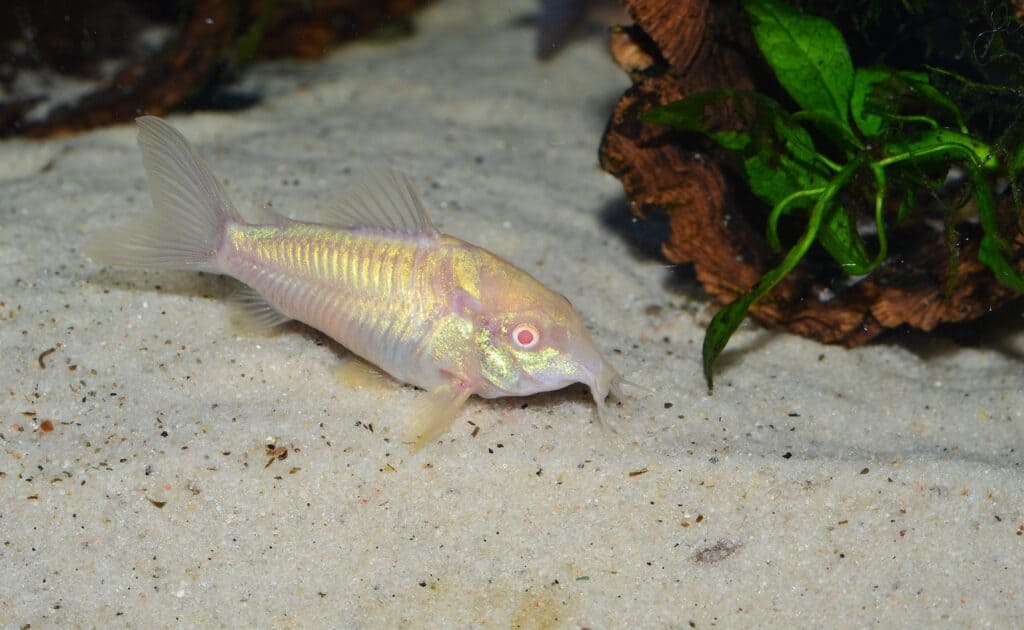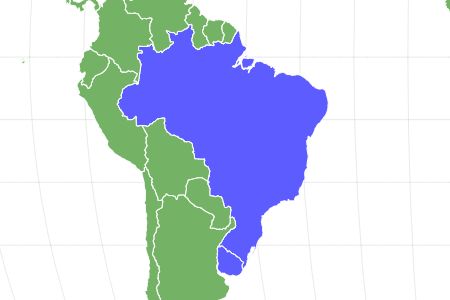Cory Catfish
All Cory Catfish have three pairs of barbels around their mouth that they use to detect food.
Advertisement
Cory Catfish Facts
- Prey
- Worms, insects, larvae, and plankton
- Name Of Young
- Fry
- Group Behavior
- School
- Fun Fact
- All Cory Catfish have three pairs of barbels around their mouth that they use to detect food.
- Most Distinctive Feature
- Armoured scales and spikey fins
- Other Name(s)
- Corydora
- Temperament
- Docile
- Diet for this Fish
- Omnivore
- Lifestyle
- Diurnal
- Crepuscular
- Number Of Species
- 161
Cory Catfish Physical Characteristics
View all of the Cory Catfish images!
Cory Catfish also referred to as Corydoras is a genus of catfish that originates from the coastal rivers in Brazil and Uruguay and the lower Parana river basin.
All species originate from rivers in South America.
They are a popular freshwater fish in the aquarium hobby and are known for being peaceful and easy to care for. Cory Catfish come in many different colors, patterns, and sizes depending on their species.
There are over 160 identified Cory Catfish species in the group and not all species of the Cory Catfish originate from the same habitats, but they all live in the same water conditions and cannot tolerate saltwater environments.
Cory Catfish Classification and Scientific Name
Cory Catfish are part of the Corydoras taxonomic genus and part of the Actinopterygii class and the phylum Chordata. The scientific name for each Cory Catfish will depend on the species. Some common Cory Catfish that are popular in the aquarium hobby include the C. paleatus, C. pygmaeus, and C. aeneus.
Cory Catfish Species
Cory Catfish is the name given to describe an entire genus that expands into the thousands, however, there are only 161 identified Cory Catfish species so far. Researchers and experts are currently studying the remaining species to find out more information. All Cory Catfish are bottom-dwelling scavengers and have a social and peaceful temperament. In the wild, Cory Catfish will form large shoals of their own species to feel safe as a group. All species of Corydoras originate from the rivers and streams located in South America.
These are some of the most common Cory Catfish species available:
- Bronze Cory: A hardy and adaptable Cory Catfish found in shallow and fast-flowing rivers throughout South America.
- Julii Cory: A freshwater fish that is native to the flooded forest floors in the Amazon Basin with a leopard appearance.
- Albino Cory: Inhabits shallow, quiet streams with a muddy appearance throughout South America and has a creamy, transparent body.
- Pepper Cory: Better adapted to cooler waters than other Corydoras and has a dark-mottled appearance hence their name.
- Bandit Cory: A sensitive Cory Catfish that grows no larger than two inches and has a cream body with a thick white band across its head to tail.
- Pygmy Cory: The smallest specie of the Corydoras growing to an inch in size and are considered bottom-dwelling nano fish.
Cory Catfish Appearance
The appearance of Cory Catfish will vary according to their species. However, all of the species do not grow much larger than 5 inches (12.7 cm) in length which makes them small nano fish. All Cory Catfish have a similar body structure, with the main differences between the species being their adult size and coloration. Male Cory Catfish are slightly smaller than females, but they have a more defined dorsal and pectoral fin.
The Pygmy Cory is the smallest species growing no larger than 1.5 inches, with the largest species being the Brochis Britskii at 7 inches in the wild. Since Cory Catfish are bottom dwellers, they have a flattened belly with blunt heads to make it easy for them to skim the substrate or the bottom of a body of water. They come in various colors ranging from cream, black, silver, brown, blue, and gold with either stripes, spots, bands, or one solid color depending on the species.
All Cory Dora has three pairs of barbels around their mouth that they use to detect food. If you have observed a Cory Dora sifting through the substrate in an aquarium, you will see that they wiggle their barbels into the substrate, along plants, rocks, and driftwood in search of food.

All Cory Catfish should be provided with smooth sand or gravel for their substrate so they don’t damage their delicate barbels.
©JuanCarlosPalauDiaz/Shutterstock.com
Cory Catfish Distribution, Population, and Habitat
All species of Corydoras originate from the streams in South America and regions of the Andes Mountains, however, the exact location can differ depending on the species’ water parameter preference.
They have a large distribution throughout the Amazon where they inhabit murky, slow-moving streams, rivers, marshes, ponds, and flooded forests. They prefer moderately warm waters which is why they are kept as tropical fish in the aquarium hobby. In the wild, Cory Catfish prefer to form large shoals in freshwaters and can be found at the bottom of these bodies of water amongst the mud and vegetation.
Since the Cory Catfish has been introduced into the aquarium trade industry, it can now be found worldwide as a shoaling bottom-dwelling fish. This fish prefers to stay in shallow water since they spend most of their time at the bottom of an aquarium or habitat due to oxygen being able to reach them more easily.
Cory Catfish Predators and Prey
Predators
Cory Catfish do not have many predators in the wild, mainly because they are covered in armored scales and spines in self-defense, and they also release toxins that can kill larger fish, such as piranhas. However, these self-defense mechanisms rarely happen in aquariums, so you do not have to worry about your Cory Catfish harming any tank mates in a community aquarium. Their spiky bodies also make it difficult for other fish to nip at them without escaping injury.
Prey
In the wild, Cory Catfish will scavenge at the bottom of murky streams and rivers in the Amazon to find worms, insects, larvae, plankton, and remains of other deceased fish (even their own species). Cory Catfish search for food by burying their snout and barbels into the mud or substrate to suck up food into their mouths. In an aquarium, Cory Catfish will eat foods that fall to the bottom of the aquarium, which can include flakes, pellets, sinking algae wafers, and any uneaten foods left over by other fish. Cory Catfish will rarely swim to the top of the aquarium to eat foods like other fish because they are not surface dwellers.
Cory Catfish Reproduction and Lifespan
Reproduction
The breeding behaviors of Cory Catfish depend on their species and the number of eggs a female Cory Catfish produces will depend on its size and age. Most female Cory Catfish will lay small clutches of eggs during spawning season and the fry (newly born or hatched fish) will hatch only a few days later. In the wild, spawning with this genus occurs during the rainy seasons, and females can lay eggs from multiple males at the same time, usually with a clutch of 10 to 20 eggs.
How Long Do Cory Catfish Live?
The lifespan of Cory Catfish will depend on the species; however, all species are able to live up to five years of age. Some Cory Catfish. However, most wild specimens can reach ages from up to 10 to 15 years with some species recorded living up to 27 years of age. In an aquarium, your Cory Catfish’s lifespan will depend on how well they are cared for which includes keeping them in a large tank with good filtration, aeration, a healthy diet, and the right water parameters that replicate the species’ preferred water conditions that they would experience in the wild.
Cory Catfish Population
Cory Catfish are spread throughout South America which is home to their original habitat. Since Cory Catfish have been introduced into the pet trade industry, they are mass bred on commercial farms and made available at various stores where they can be purchased. Most of the species of Cory Catfish that are available as pets have the highest population around the world and they are not considered endangered because they are widely distributed and there are no widespread threats that affect the Cory Catfishes population according to the IUCN red list.
5 Facts About Cory Catfish
- Cory Catfish can produce a sound by the abduction of their pectoral fins and is used by males as a form of intrapersonal communication during courtship, or by both males and females when they feel stressed.
- Researchers have identified up to 161 different species of Corydoras that each has their own coloration, shape, and size with one species of Cory Catfish that has unfortunately gone extinct (C. revelatus).
- Some Cory Catfish shoals or schools can contain over a hundred fish in their natural habitat, which makes this a social fish species.
- Cory Catfish rarely grow larger than 5 inches (12.7 cm) in size.
- There are thousands of Cory Catfish species that researchers have not yet identified and are currently being studied.
Cory Catfish FAQs (Frequently Asked Questions)
Where are Cory Catfish found?
Cory Catfish can be found throughout South America from the Andes to the Atlantic coast, all the way to Trinidad to northern Argentina in the Rio de le Plata drainage. They are not found in Panama, and the area where Cory Catfish are commonly distributed from the same genus is nearly equal to the entire Cory Catfishes family distrubution.
They have more restricted geographic location than other callichthyids. Since most species of the Cory Catfish have been introduced into the aquarium industry, they can be found throughout the world and are bred for aquarium trading.
Thank you for reading! Have some feedback for us? Contact the AZ Animals editorial team.
Sources
- Animals Network Team, Available here: https://animals.net/cory-catfish/
- Wikipedia , Available here: https://en.wikipedia.org/wiki/Corydoras
- Animals net, Available here: https://animals.net/cory-catfish/

















